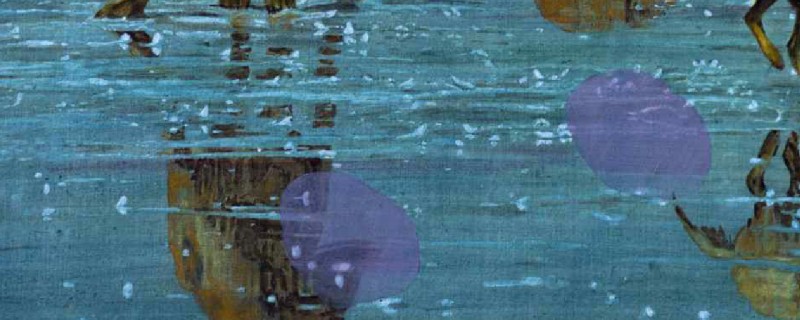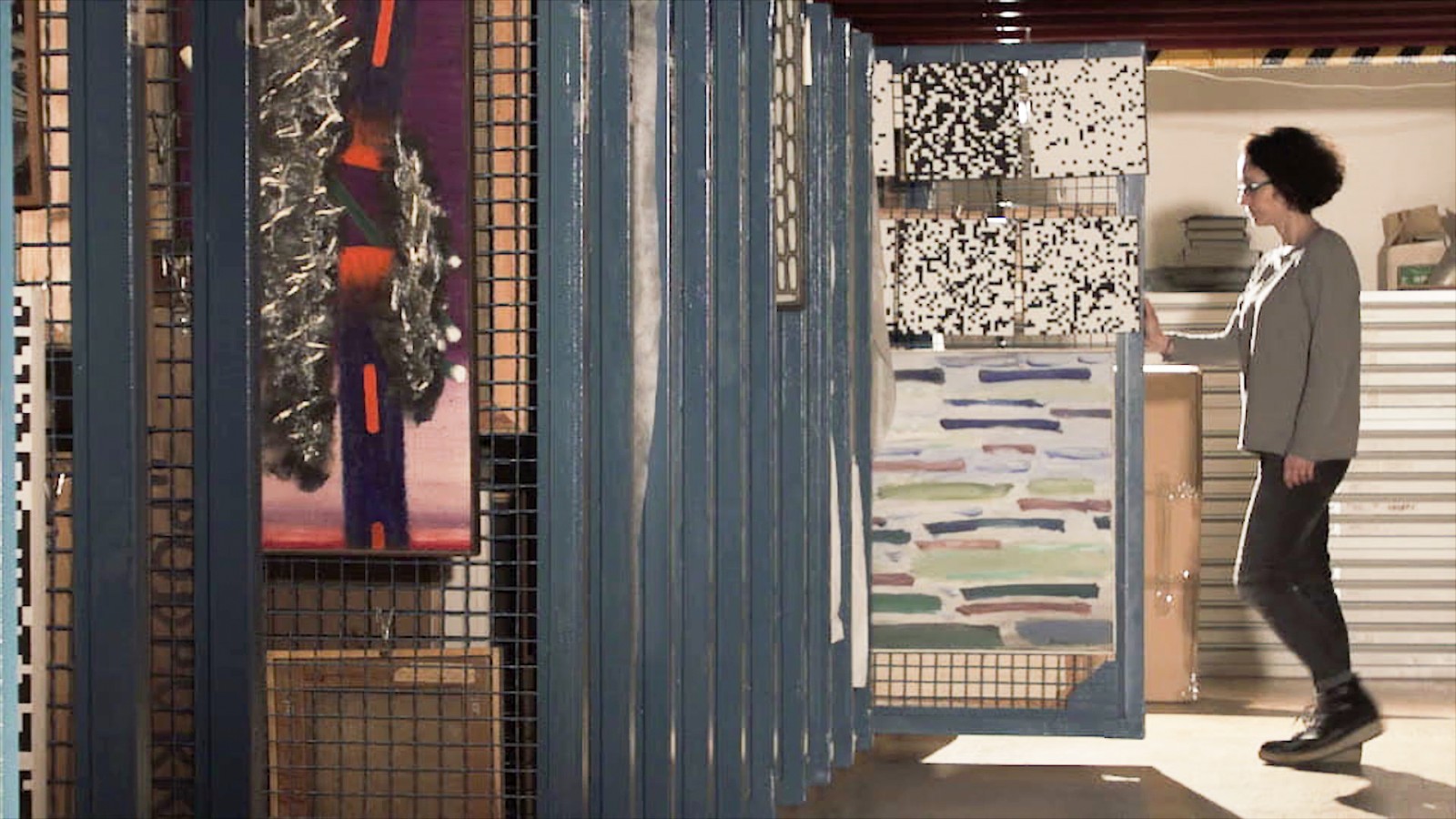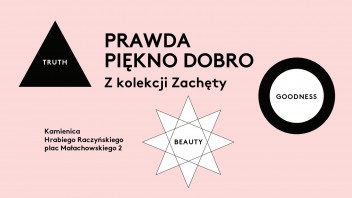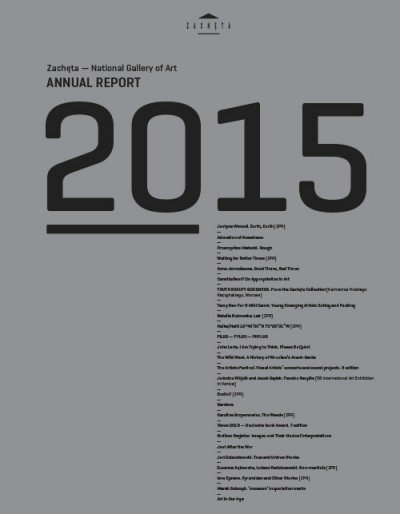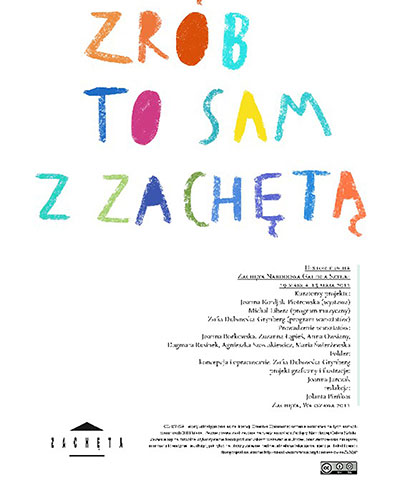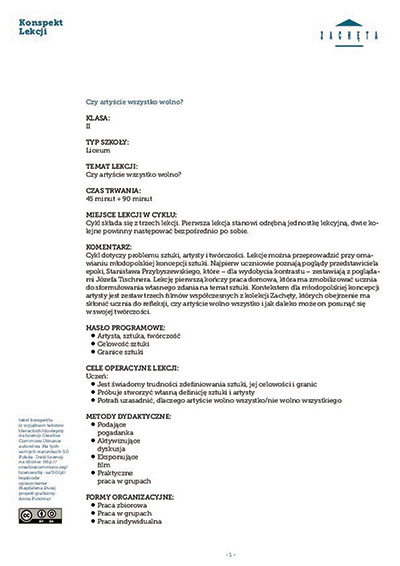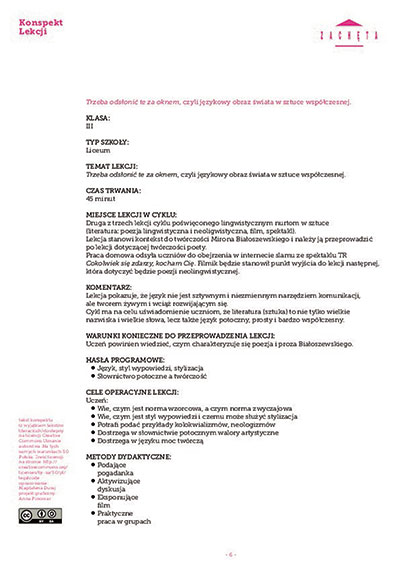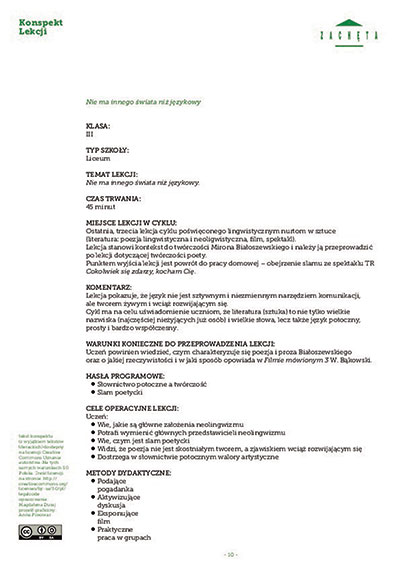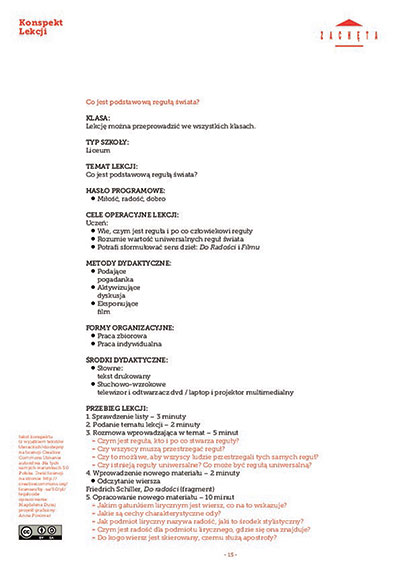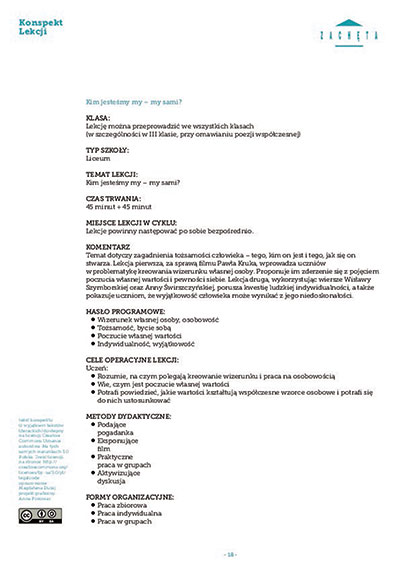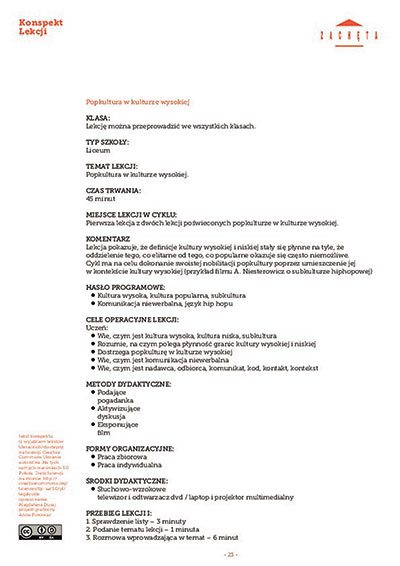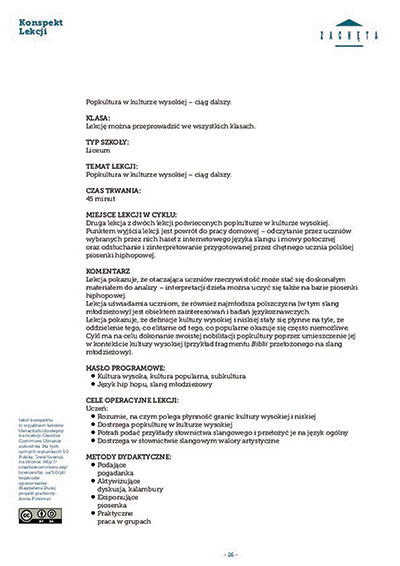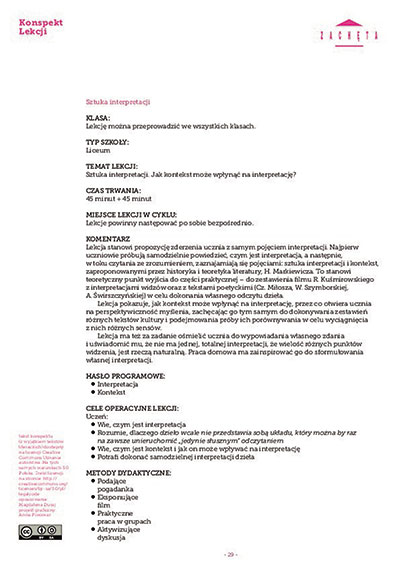Publikacja udostępniana jest na licencji Creative Commons.
Publication date: 15.04.2015
Zofia Dubowska: Can the exhibition TRUTH BEAUTY GOODNESS. From the Zachęta Collection give viewers an idea of the collection’s history?
Maria Krawczyk: Well, yes and no. The exhibition doesn’t show the whole story, but only some of its aspects. Most of the works exhibited come from purchases made after 1989. There is considerable representation of artists from the young and middle generations. Sure enough, I spotted a big painting by Erna Rosenstein, from the earlier purchases in the days of Gizela Szancer [Director of the Central Bureau of Art Exhibitions (CBWA), 1954–1968]. I remember when she started working at the Zachęta in 1966. From 1967, I helped establish Zachęta’s department for coordinating with the Bureaus of Art Exhibitions (BWA).
How many BWAs were there in Poland?
MK: When the department was being established, they were operating in 15 voivodships.
Barbara Dąbrowska: After the administrative reform in Poland [in 1975] — 49. Every voivodship had a local [BWA] office. Sometimes there were several such establishments in each voivodship.
MK: Some galleries were built from scratch, like in Katowice or Bydgoszcz. But generally they were attached to other institutions.
BD: Initially, the Central Bureau of Art Exhibitions only had two departments, responsible for programming and education, and technical matters. The Programme and Education Department basically dealt with everything. The Technical Department expanded and later split into the Execution and Technical Departments. Only later were the External Relations, Editorial, and Documentation departments added. And still later, yet another kind of department when the central planning of exhibitions was moved from the Ministry of Culture and Arts.
MK: I started by preparing exhibitions for Bureaus of Art Exhibitions. We mainly needed to assist them with organising exhibitions ‘in the field’. We sent sets of beautifully framed reproductions, but our ambition was to reach them with authentic works of art.
BWAs exhibited reproductions?
MK: In the institutions under the supervision of the BWA — in small community centres, schools, fire stations, etc. It was an educational activity, supervised by the Education Department, but also by the External Relations Department.
BD: And each department at the Zachęta had their own storeroom. . .
MK: In our [External Relations Dept.] storeroom we kept portfolios of ready-made sets — such exhibitions were in high demand, but we mainly had graphic art, works framed in glass and so on. In preparing these exhibitions I also pulled from Zachęta storerooms.
Thinking about the Zachęta in the 1950s and 1960s, I see it as an institution totally subordinated to the Ministry of Culture and Arts, and in terms of artworks as a kind of repository or storage for objects belonging to others. Since when have we been able to talk about the Zachęta’s autonomy and creating its own collections?
BD: Only since after the political transformation, after 1989. It’s difficult to speak about any decision-making ability of the Zachęta before the transition period. The ministry used the central budget to buy works of art from various funds, such as the State Fund of Visual Arts Commissions and the Visual Arts Development Fund.
Mieczyslaw Ptaśnik [CBWA director, 1977–1989] mentioned [in a 2010 interview by Maria Świerżewska] scholarship and procurement funds.
BD: We weren’t included in the scholarship fund because it remained completely at the discretion of the ministry. Obviously, various measures were taken, like, they would no longer buy paintings from someone who got a scholarship. But basically, how it was in the Zachęta, purchases were made on the Ministry’s orders.
MK: Still, a lot was left up to the director and their team. As I mentioned, I briefly worked with director Gizela Szancer. She had a huge impact on the shaping of the programme (no doubt thanks to good connections at the Ministry and the Central Committee of the PZPR party) and on making purchases. During her time, there were many valuable exhibitions, for example the Henry Moore exhibition in 1959. And that’s not the only example.
Some works were also bought by the Zachęta as gifts for cabinets of other ministries . . .
MK: That was an entirely different pool — orders from ministries and probably from the Central Committee.
BD: They had a commission in charge of all that, but at the ministry. What we got was the ‘final product’. Remember these situations? The girls dealing with the so-called transition storeroom tearing their hair out because they didn’t know where they’d find room for it all. All the storerooms were horribly crammed. From time to time they had an idea — we’ll buy from some exhibition, from some contest, or some author. I can remember a huge purchase of Bronisława Wilimowska’s works from her individual exhibition, during Martial Law (1983).
Nobody cared what happened next with those purchased objects?
BD: Sometimes we got a recommendation to give them to other institutions. Some of the Visual Arts Development Fund’s purchases (from which they bought not-so-bad and sometimes very good things) were made not for the Zachęta, but for other museums.
MK: I bought a huge amounts of graphics, because I organised many graphics exhibitions abroad. I prepared several sets that went on a tour around various countries both near and very far away, and I often managed to travel with the exhibitions. It was clear that with travelling exhibitions the exhibits could be damaged or destroyed, so in such cases the Zachęta officially asked the ministry to buy them. This was the case with one exhibition that was to be shown in Denmark in the 1980s. Martial law disrupted preparation of the exhibition and it came to fruition only in 1984. When it became clear that the graphics would have to be mothballed for several years, I asked the ministry to buy them. And they’re owned by the Zachęta now.
The works that were bought for exhibitions later remained at the Zachęta. So, this was already a ‘collection’. Purchased graphics were moved to an ‘author-based’ storeroom where they were kept in drawers, given inventory numbers and entered into an inventory book.
What about other exhibitions, what else contributed to the enlargement of the collection?
BD: In the seventies, Bożena Kowalska [Head of the Education Department, 1952–1984] organised graphics exhibitions at companies, as part of the An alliance between the world of work and art and culture campaign. These were good exhibitions, prepared entirely by the Education Department.
Today we would call them ‘projects’. How long did that project last?
BD: From the mid-1970s until the 1980s. The purchases were made by experts. The exhibitions were individual, and employees of the Education Department wrote the text for the catalogues. Sometimes, if the artist agreed, the exhibitions were accompanied by meetings with the artists, as well as lectures, slideshows, etc. I remember a very interesting meeting at a hotel for the Warsaw steelworks workers — they were extremely well-read and open-minded. The Education Department staged these exhibitions in Warsaw, and we had a van that we used to carry the repro exhibitions to schools, detention centres, army barracks and so on. The graphics exhibitions were also shown in work places and on business premises.
I also wanted to talk about the cooperation between the BWAs and the CBWA. Between 1983 and 1985, Bożena Kowalska prepared three didactic exhibitions on the geometric current, the metaphorical current, and what we then called the feature current, but is today known as the figurative current. So these three exhibitions, featuring several artists and several dozen pieces, were organised with the CBWA and several BWAs. The Education Department only rarely staged exhibitions with the BWAs. The art purchased for the geometric exhibition gave rise to further purchases and development of a distinctive part of the Zachęta’s collection. Now, the TRUTH BEAUTY GOODNESS exhibition features the entire collection of works by Stażewski purchased in the 1980s. The metaphoric current is represented by works from Erna Rosenstein, and a piece by Jan Rylke.
The Bureaus of Art Exhibitions were in a better situation than the Zachęta. For staging regular shows, for example, of small sculptural forms, they were able to buy the pieces, profiling their collections. However, at the Zachęta, as I remember, there was this top-down atmosphere of distancing ourselves from the past, from the pre-war Society for the Encouragement of Fine Arts. The Zachęta was supposed to be just a gallery. The Society for the Encouragement of Fine Arts had its collection, but after the war it was transferred to the National Museum in Warsaw. The Zachęta was allowed to have a limited repository of art for educational purposes, roadshows, exchanges of exhibitions with BWAs and so on, but it wasn’t supposed to have its own collections!
MK: Its very name — the Central Bureau of Art Exhibitions — indicates that it was mainly about administration and bureaucracy, rather than museum ambitions or art collections.
Were there any situations where the Zachęta bought something on the Ministry’s orders, and then it was taken away?
BD: There was an indescribable mess. Teresa Sowińska [who worked at the Zachęta from 1967–1999, initially in Education Department, then from 1992 as the curator of collections] once told us that in the 1990s, when they were sorting out and merging all the storerooms — at the end there were perhaps 17 of them — she found a dozen or so paintings without any corresponding entries in the inventory. The storerooms were mixed, and there was a perennial shortage of space.
MK: A lot of art got left behind after exhibitions, unclaimed by any of the artists.
BD: The Ministry felt at home here, they took our pieces and deposited them with other institutions, offices, you name it. Wanda Podoska, Head of the Organisation and Services Unit [1977–1988], deserves great credit here for reclaiming these pieces from various institutions, but most of all she didn’t heed orders, like, ‘Please, send such and such painting to this or that person’. She always asked for receipts and kept the documentation in order. She was employed to sort out formal issues.
Where were the storerooms located?
BD: The storerooms were in the basement, although the largest, ‘Artists’ storeroom, was on the ground floor where the workshop is today. The storerooms of the Education, Services and Sales Departments were down below.
Barbara Majewska had a difficult job. She was the director for just four years [1989–1993]. Did she revisit the idea of the collection?
BD: Yes, it was under her management that the first stocktaking, sales and new acquisitions took place.
So Barbara Majewska began consolidating the storerooms, cleaning, checking what was in there, returning pieces to artists who hadn’t collected them after exhibitions. Teresa Sowińska was appointed as the curator of collections and was made responsible for sorting out all the ‘resources’. Previously, there were all kinds of documents, but none of the artworks had matching inventory cards.
BD: I remember the horrible searches for the authors. . .
MK: Browsing through the earlier inventory books, I really felt utter despair. . .
BD: You know what these inventories were like? Of course, no photographs. I had an inventory book on reproductions. A4 notebooks were used for everything: reproductions, slides, artwork, medals — all put together. We got rid of the medals and pottery double fast. It’s not true that the socialist realism pieces from the 1950s were sold off by Director Majewska. Lots of them were sent to the Kozłówka museum after the thaw, and what was left was really such poor quality that there was nothing to regret. Such ‘clean-ups’ were done several times. I can’t remember the first sales from the beginning of the 1990s, but three or four were organised. First we got rid of the oldest and most horrible plaster-cast figures. Numerous pieces in the storeroom were anonymous, bearing only a pseudonym rather than the author’s name, submitted for competitions and never collected again. Director Ptaśnik said that some artists would wait until the piece was worn and torn, in order to claim compensation. But the auctions and sales were not only aimed at getting rid of old, weak art, but also — and this was under Anda Rottenberg’s management [1993–2001] — we were very clearly told to sell things that didn’t fit the collection’s profile.
How did the purchase committees work?
BD: Always in the same way. In Director Ptaśnik’s times, Deputy Director Rostkowski [Stanisław, deputy director of the CBWA, 1978–1990] would come and say that you needed this and that. He was a communist party-appointed director, so he just offered ideas along the lines of ‘ideological correctness’.
Marysia, do you feel responsible for purchasing any artwork for the Zachęta?
MK: I feel responsible only for those pieces that I recommended. For all graphics purchases — I wouldn’t have missed any of them, I’m glad. I draw particular satisfaction from the fact that the Zachęta obtained a valuable collection of paintings by Zbigniew Tymoszewski. In 1993 I prepared an exhibition of his art at the Zachęta. At my request, Marek Ludwiczuk, the painter’s nephew and legal heir was given all of Tymoszewski’s canvases that had been deposited in our storerooms since 1963. They were then moved to the CBWA after Tymoszewski’s posthumous exhibition at the ZPAP Art Gallery in Warsaw’s MDM district.
Who deserves most credit for taking care of the collection?
MK: When it comes to organisation, that would without doubt be Teresa Sowińska. And Wanda Podoska. And, actually, the professional care of the collections at the Zachęta is a recent thing. The Collections Department was established in Director Agnieszka Morawińska’s time [2001–2010], after 2000.
BD: Because Agnieszka Morawińska is a museologist.
MK: Teresa Sowińska mentioned that she was not a museologist, so she had to learn everything from scratch. She entered an environment of monstrous chaos, constant construction works, dust, temperature changes, etc. A professional art storehouse was created only after the Zachęta’s extension in 1995.
I started working at the Zachęta in 1996 to help Teresa Sowińska, who was organising the collection. My first task was to create inventory cards for deposited graphics. I got a big pile of prints, I would sign the names of their authors, measure them and typewrite the cards. Now I understand what I participated in. Sowińska did a tremendous job, she cleaned the Augean stables.
And how do you like the current exhibition?
BD: The exhibition is eclectic, but it mainly shows the works of artists that were brought to the Zachęta after 1989. But we shouldn’t forget about the core, which we owe to Maria Domurat [Krawczyk] and Bożena Kowalska.
MK: I feel sentimental about the exhibition, because I know and remember most of the pieces. It shows a cross-section of the collection — from Janusz Kaczmarski to Joanna Rajkowska, beautiful paintings by Henryk Stażewski . . . It presents pieces from different drawers and what can be found in the Zachęta’s current collection. I feel good being here.
Barbara Dąbrowska — art historian, worked at the Zachęta in 1972–2008, long-time Director of the Education Department. Since 2008 she has run a series entitled Look/See. Contemporary Art and Seniors at the Zachęta.
Maria Krawczyk (previously Domurat) — art historian, worked at the Zachęta in 1966–2000. Created and headed the External Relations Department, and since 1990 has been Head of the Documentation Department. Curator, author of numerous catalogue texts.
Zofia Dubowska — art historian, has worked at the Zachęta since 1996, currently Head of Education Department and author of two children’s books on contemporary art
-
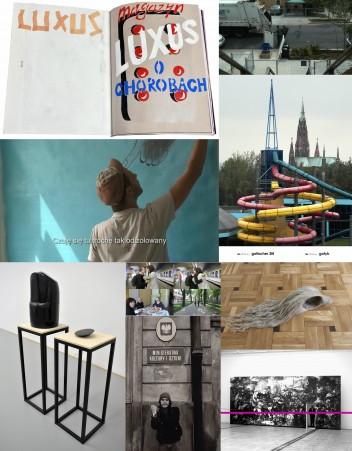 05.12.2016 – 01.01.2017Collections
05.12.2016 – 01.01.2017CollectionsThis year’s show is dedicated mainly to our sponsors: those who supported our collection through crowdfunding or in other ways. This years’ acquisitions are presented in the context of other classical works from our collection — a group of Edward Dwurnik’s works and of the Egit Foundation’s deposit, which has been in our charge for many years.
Zachęta – National Gallery of ArtZachęta
